Further information: List of headgear
This is a list of various kinds of hat, contemporary or traditional. Headgear has been common throughout the history of humanity, present on some of the very earliest preserved human bodies and art.
| Image | Name | Description | Refs. |
|---|---|---|---|

|
Akubra | An Australian brand of bush hat, whose wide-brimmed styles are a distinctive part of Australian culture, especially in rural areas. | |

|
Ascot cap | A hard style of hat, usually worn by men, dating back to the 1900s. Sometimes associated with livestock slaughter. | |

|
Ayam | A traditional Korean winter cap mostly worn by women in the Joseon and Daehan Jeguk periods (1392–1910). | |

|
Balaclava | Headgear, usually made from fabric such as cotton and/or polyester, that covers the whole head, exposing only the face or part of it. Sometimes only the eyes or eyes and mouth are visible. Also known as a ski mask. | |
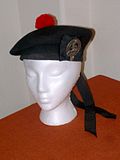
|
Balmoral bonnet | Traditional Scottish bonnet or cap worn with Scottish Highland dress. | |

|
Barretina | A floppy fabric pull-on hat, usually worn with its top flopped down. In red, it is now used as a symbol of Catalan identity. | |

|
Baseball cap | A type of soft, light cotton cap with a rounded crown and a stiff, frontward-projecting bill. | |

|
Beanie | A brimless cap, with or without a small visor, once popular among schoolboys. Sometimes includes a propeller. Note: In New Zealand, Australia, the United Kingdom, and parts of the United States, "beanie" also or otherwise refers to the knit cap or tuque used during winter to provide warmth. |
|

|
Bearskin | A tall fur cap, usually worn as part of a ceremonial military uniform. Traditionally, the headgear of grenadiers, and remains in use by grenadier and guards regiments in various armies. Sometimes mistakenly identified as a busby. | |

|
Beret | A soft round cap, usually of woollen felt, with a bulging flat crown and tight-fitting brimless headband. Worn by both men and women and traditionally associated with France, Basque people, and militaries. | |

|
Bhadgaunle Topi | A typical Nepali cap. | |

|
Bicorne | A broad-brimmed felt hat with brim folded up and pinned front and back to create a long-horned shape. Also known as a cocked hat. Worn by European military officers in the 1790s and, as illustrated, commonly associated with Napoleon. | |
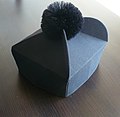
|
Biretta | A square cap with three or twelve ridges or peaks worn by Roman Catholic (and some Anglican and Lutheran) clergy. | |

|
Blangkon | A traditional Javanese men's hat. | |

|
Boater | A flat-brimmed and flat-topped straw hat formerly worn by seamen. Schools, especially public schools in the UK, might include a boater as part of their (summer) uniform. Now mostly worn at summer regattas or formal garden parties, often with a ribbon in club, college or school colors. | |

|
Boonie hat | A soft, wide-brimmed cotton hat commonly used by military forces. Also known as a bush hat and similar to a bucket hat. | |

|
Börk | A high cap wore by Janissaries as a symbol of their devotion to their order in the Ottoman Empire. | |

|
Boss of the Plains | A lightweight all-weather hat, with a high rounded crown and wide flat brim, designed by John B. Stetson for the demands of the American frontier. | |

|
Boudoir cap | A type of decorative cap mainly worn in the 19th and early 20th century with sleepwear or lingerie. | |

|
Bowler hat | A hard felt hat with a rounded crown created in 1850 by Lock's of St James's, the hatters to Thomas Coke, 2nd Earl of Leicester, for his servants. More commonly known as a Derby in the United States. | |

|
Breton | A woman's hat with round crown and deep brim turned upwards all the way round. Said to be based on hats worn by Breton agricultural workers. | |

|
Bucket hat | A soft cotton hat with a wide, downwards-sloping brim. | |

|
Budenovka | A soft, woolen hat covering the ears and neck, worn by Soviet troops from 1918 to 1940. | |
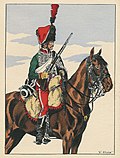
|
Busby | A small fur military hat. | |

|
Bycocket | A wide brimmed hat that is turned up in the back and pointed in the front like a bird's beak. Traditionally associated with the character Robin Hood. | |
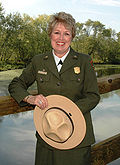
|
Campaign hat | Also known as a "Smokey Bear" hat. A broad-brimmed felt or straw hat with high crown, pinched symmetrically at its four corners (the "Montana crease"). | |

|
Capirote | A conical pointed hat with eye holes. Historically associated with the Ku Klux Klan in the United States of America, but still used elsewhere in other contexts (such as the example illustrated, featuring people from Nazareno processing during Holy Week in Spain). | |
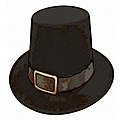
|
Capotain | A hat worn between the 1590s and 1640s in England and northwestern Europe. Also known as a "Pilgrim hat" in the United States. | |

|
Cappello romano | A round wide-brimmed hat worn by more traditional Roman Catholic clergy. | |
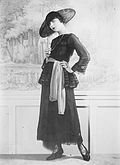
|
Cartwheel hat | Wide-brimmed and shallow-crowned hat, normally worn at an angle. Popular from 1910s but most closely associated with 1940s-50s fashion. | |

|
Casquette | A small-peaked cap often worn by cyclists. | |

|
Caubeen | An Irish beret. | |

|
Cavalier hat | A wide-brimmed hat popular in 17th-century Europe. | |

|
Chengziguan | A traditional horse hair hat dating back to 10th century China, which later became popular among the yangban of Joseon Dynasty Korea as an alternative to the gat. | |

|
Chilote cap | A woven cap, typical of Chiloé Archipelago, that is made of coarse raw wool and usually topped by a pom-pom. | |

|
Chullo | Peruvian or Bolivian hat with ear-flaps made from vicuña wool, alpaca, llama or sheep's wool. | |

|
Chupalla | A straw hat made in Chile. | |

|
Cloche hat | A bell-shaped woman's' hat that was popular during the Roaring Twenties. | |

|
Coal scuttle bonnet | A woman's bonnet with stiffened brim and a flat back (crown). | |
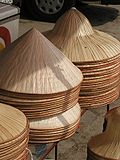
|
Conical Asian hat | A conical straw hat associated with East and Southeast Asia. Sometimes known as a "coolie hat", although the term "coolie" may be interpreted as derogatory. | |
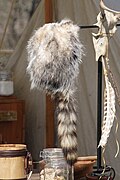
|
Coonskin cap | A hat, fashioned from the skin and fur of a raccoon, that became associated with Canadian and American frontiersmen of the 18th and 19th centuries. | |

|
Sombrero Cordobés | A traditional flat-brimmed and flat-topped hat originating from Córdoba, Spain, associated with flamenco dancing and music and popularized by characters such as Zorro. | |

|
Cricket cap | A type of soft cap traditionally worn by cricket players. | |

|
Custodian helmet | A helmet traditionally worn by British police constables while on foot patrol. | |

|
Deerstalker | A warm, close-fitting tweed cap, with brims front and behind and ear-flaps that can be tied together either over the crown or under the chin. Originally designed for use while hunting in the climate of Scotland. Occasionally worn by – and so closely associated with – the character Sherlock Holmes, rarely in the original stories or their illustrations, but often in films. | |
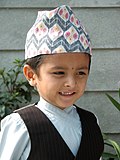
|
Dhaka topi | A typical Nepali cap made up of fabric called dhaka | |

|
Dixie cup hat | Also known as "gob hat" or "gob cap." A sailor cap worn in several navies, of white canvas with an upright brim. | |

|
Draped turban | A fashion dating back to at least the 18th century, in which fabric is draped or moulded to the head, concealing most or all of the hair. Original designs were said to be inspired by the turbans of India and the Ottoman Empire | |

|
Dunce cap | A conical hat, usually tall and narrow, worn by late-19th and early-20th century school pupils as a punishment and/or humiliation. It often featured a large capital "D" inscribed on its side, to be shown frontwards when the hat was worn. | |
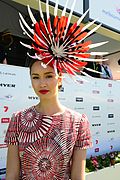
|
Fascinator | A small hat commonly made with feathers, flowers and/or beads. | |

|
Fedora | A soft felt hat with a medium brim and lengthwise crease in the crown. | |

|
Fez | Red felt hat in the shape of a truncated cone, common in Arab countries. | |

|
Flat cap | A soft, round wool or tweed men's cap with a small bill in front. | |

|
Gandhi cap | Typical cotton white cap named after Mahatma Gandhi 'father of nation' of India. Mostly worn by Indian politicians and people. | |

|
Garrison or Forage cap or side hat | A foldable cloth cap with straight sides and a creased or hollow crown. | |

|
Gat | A traditional Korean hat worn by men. | |

|
Gatsby | A soft brimmed hat popular in New York after the turn of the century made from eight quarter panels. Also known as a newsboy cap. | |

|
Gaung Paung | Headwrap worn by the Bamar, Mon people, Rakhine and Shan peoples. | |

|
Glengarry | A traditional Scottish boat-shaped hat without a peak made of thick-milled woollen material with a toorie on top, a rosette cockade on the left, and (usually) ribbons hanging down behind. It is normally worn as part of Scottish military or civilian Highland dress. | |

|
Green eyeshade | Once common-wear for office clerks. | |
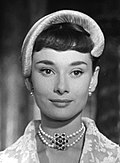
|
Half hat | Millinery design that covers only half the head – particularly popular in the 1950s. | |

|
Halo hat | Semi-circular or circular design that frames the face, creating a 'halo' or 'aureole' effect. | |

|
Hard hat | A rounded rigid helmet with a small brim predominantly used in workplace environments, such as construction sites, to protect the head from injury by falling objects, debris and bad weather. | |

|
Hardee hat | Also known as the 1858 Dress Hat. Regulation hat for Union soldiers during the American Civil War. | |

|
Hennin | A woman's hat of the Middle Ages. This style includes the conical "princess" hats often seen in illustrations of folk-tale princesses. | |

|
Homburg | A semi-formal hat with a medium brim and crown with a crease and no dents. | |

|
Icelandic tail-cap | Part of the national costume of Iceland. | |

|
Jaapi | A traditional hat of Assam, India. Plain and decorative jaapis are available. | |

|
Kalpak | A traditional hat of Bulgaria, Turkey, Ukraine and Central Asia. Made primarily of lamb fur, it comes in a variety of regional styles. | |

|
Karakul | A hat made from the fur of the Karakul breed of sheep, typically worn by men in Central and South Asia. | |

|
Keffiyah or Ghutrah | Three piece ensemble consisting of a Thagiyah skull cap, Gutrah scarf, and Ogal black band. | |

|
Kepi | A generic worldwide military hat with a flat, circular top and visor. First seen in central Europe. | |

|
Kippah or Yarmulke | A close-fitting skullcap worn by religious Jews. | |

|
Kofia | Brimless cylindrical cap with a flat crown, worn by men in East Africa. | |

|
Kolah namadi | A felt hat, typically worn by men in the rural areas of Iran. | |

|
Kolpik | Brown fur hat worn by Hassidic Jews. | |

|
Kova tembel | Cloth hat worn by Israeli pioneers and kibbutzniks. | |
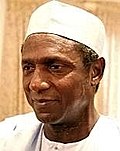
|
Kufi | A brimless, short, rounded cap worn by Africans and people throughout the African diaspora. | |

|
Kupiah | Traditional cap from Aceh. | |
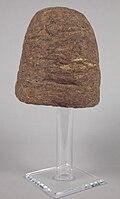
|
Labbadeh | A conical brimless felt cap, traditionally worn by Lebanese men in rural areas. | |
| Makapili Hat | Bamboo basket worn over the head covering the entire head with just holes for the eyes and worn by some members of the Makapili, Filipinos who were Japanese collaborators during World War II in the Philippines. | ||

|
Mathal | Distinctive hat worn by farmers in the Bangladesh made of bamboo with a conical top. | |

|
Mitre | Distinctive hat worn by bishops in the Roman Catholic Church, Eastern Orthodox Church, and the Anglican Communion. | |

|
Mobcap | A round, gathered or pleated cloth bonnet worn indoors, or outdoors under a hat, by women in the 18th and 19th centuries. | |

|
Montera | A crocheted hat worn by bullfighters. | |

|
Mortarboard | Flat, square hat. Usually has a button centered on top. A tassel is attached to the button and draped over one side. Worn as part of academic dress. Traditionally, when worn during graduation ceremonies, the new graduates switch the tassel from one side to the other at the conclusion of the ceremony. | |
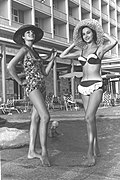
|
Mushroom hat | Hat with a distinctly downward-facing brim similar to the shape of a mushroom or toadstool. Popular from the 1870s, but particularly associated with the Edwardian era and Dior's "New Look." | |

|
Newsboy cap | Casual-wear cap similar in style to the flat cap. Like a flat cap, it has a similar overall shape and stiff peak (visor) in front, but the body of the cap is rounder, fuller, made of eight pieces, and panelled with a button on top and often with a button attaching the front to the brim. | |

|
Pakul | Round, rolled wool hat with a flat top, common in Pakistan and Afghanistan. | |

|
Panama | Straw hat made in Ecuador. | |

|
Papakhi | Also known as astrakhan hat in English, a male wool hat worn throughout the Caucasus. | |

|
Party hat | A conical hat, similar to the dunce cap, often worn at birthday parties and New Year's Eve celebrations. It is frequently emblazoned with bright patterns or messages. | |

|
Patrol cap | Also known as a field cap, a scout cap, or in the United States a mosh cap; a soft cap with a stiff, rounded visor, and flat top, worn by military personnel in the field when a combat helmet is not required. | |
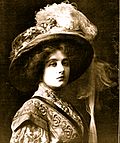
|
Peach basket hat | A woman's hat resembling an upturned fruit basket. Usually lavishly trimmed, it achieved notoriety in the early 1900s. | |
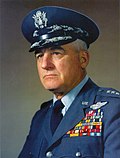
|
Peaked cap | A military style cap with a flat sloping crown, band and peak (also called a visor). It is used by many militaries of the world as well as law enforcement, as well as some people in service professions who wear uniforms. | |
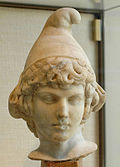
|
Phrygian cap | A soft conical cap pulled forward. In sculpture, paintings and caricatures it represents freedom and the pursuit of liberty. The popular cartoon characters The Smurfs wear white Phrygian caps. | |
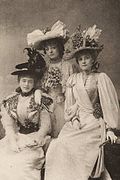
|
Picture hat | Also known as a Gainsborough hat and garden hat, this is an elaborate women's design with a wide brim. | |

|
Pilgrim's hat | A pilgrim's hat, cockel hat or traveller's hat is a wide brim hat used to keep off the sun. It is highly associated with pilgrims on the Way of St. James. The upturned brim of the hat is adorned with a scallop shell to denote the traveller's pilgrim status. | |

|
Pillbox hat | A small hat with straight, upright sides, a flat crown, and no brim. | |

|
Pith helmet | A lightweight rigid cloth-covered helmet made of cork or pith, with brims front and back. Worn by Europeans in tropical colonies in the 19th century. The pith helmet is an adaptation of the native salakot headgear of the Philippines. | |

|
Planter's hat | A lightweight straw hat, with a wide brim, a round crown and narrow round dent on the outside of the top of the crown. Worn by Clark Gable in Gone with the Wind, and Paul Bettany in Master and Commander. | |

|
Poke bonnet | A woman's bonnet with a small crown and wide and rounded front brim. | |
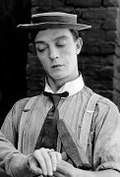
|
Porkpie | Felt hat with low flat crown and narrow brim. | |

|
Printer's hat | Traditional, box-shaped, folded paper hat, formerly worn by tradesmen such as carpenters, masons, painters and printers. | |

|
Qeleshe | A white brimless felt cap traditionally worn by Albanians. Also known as a plis or qylaf. | |

|
Rastacap | A tall, round, usually crocheted and brightly colored, cap worn by Rastafarians and others with dreadlocks to tuck their locks away. | |

|
Rogatywka | A characteristic field cap worn by partisans in World War II guerrilla fights as well by the officers of Polish armies. | |

|
Sami hat | Also known as a "Four Winds" hat, traditional men's hat of the Sami people. | |

|
Sailor cap | A round, flat visorless hat worn by sailors in many of the world's navies | |
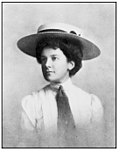
|
Sailor hat | A flat-crowned, brimmed straw hat inspired by nineteenth century sailors' headgear. | |

|
Šajkača | Serbian national and traditional hat worn by men. | |

|
Salakot | A traditional hat in the Philippines. | |

|
Santa Hat | A floppy pointed red hat trimmed in white fur traditionally associated with Christmas. | |

|
Shako | A tall cylindrical military cap, usually with a visor, badge, and plume. | |

|
Shovel hat | A hat with low, round crown and a wide brim, which projected in a shovel-like curve at the front and rear and was often worn turned up at the sides. Formerly associated with the Anglican clergy. | |

|
Shtreimel | A fur hat worn by married Hassidic men on Shabbat and holidays. | |

|
Slouch | Generic term covering wide-brimmed felt-crowned hats often worn by military leaders. Less fancy versions can be called bush hats. | |

|
Smoking cap | A soft cap, shaped like a squat cylinder or close fitting like a knit cap, and usually heavily embroidered with a tassel on top worn by men while smoking to stop their hair from smelling of tobacco smoke. | |

|
Sombrero | A Mexican hat with a conical crown and a very wide, saucer-shaped brim, highly embroidered made of plush felt. | |

|
Songkok | A cap widely worn in Indonesia, Brunei, Malaysia, Singapore, the southern Philippines and southern Thailand, mostly among Muslim males. | |

|
Sou'wester | A traditional form of collapsible oilskin rain hat that is longer in the back than the front to protect the neck fully. A gutter front brim is sometimes featured. | |

|
Stetson | Also known as a "Cowboy Hat". A high-crowned, wide-brimmed hat, with a sweatband on the inside, and a decorative hat band on the outside. Customized by creasing the crown and rolling the brim. | |

|
Student cap | A cap worn by university students in various European countries. | |

|
Sun hat | A hat which shades the face and shoulders from the sun. | |

|
Tam o' Shanter | A Scottish wool hat originally worn by men. | |

|
Taqiyah | A round fabric cap worn by Muslim men. | |

|
Tengkolok | A traditional Malay, Indonesian and Bruneian male headwear. It is made from long songket cloth folded and tied in particular style (solek). | |

|
Top hat | Also known as a beaver hat, a magician's hat, or, in the case of the tallest examples, a stovepipe (or pipestove) hat. A tall, flat-crowned, cylindrical hat worn by men in the 19th and early 20th centuries, now worn only with morning dress or evening dress. Fictional characters such as Uncle Sam and Mr. Monopoly are often depicted wearing such hats. Once made from felted beaver fur. | |

|
Toque | A tall, pleated, brimless, cylindrical hat traditionally worn by chefs. Also called a "chef's hat". | |
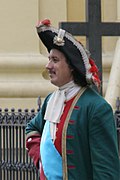
|
Tricorne | A soft hat with a low crown and broad brim, pinned up on either side of the head and at the back, producing a triangular shape. Worn by Europeans in the 18th century. Larger, taller, and heavily ornamented brims were present in France and the Papal States. | |

|
Trilby | A soft felt men's hat with a deeply indented crown and a narrow brim often upturned at the back. | |

|
Trucker hat | Similar to a baseball cap, usually with a foam brim and front section and a breathable mesh back section. | |

|
Tubeteika | A round, slightly pointed cap with embroidered or applique patterns worn throughout Central Asia. | |

|
Tudor bonnet | A soft round black academic cap with a stiff brim that has a cord with tasseled ends knotted around the base of the crown, the ends draping over the brim. | |
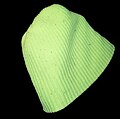
|
Tuque | In Canada, a knitted hat, worn in winter, usually made from wool or acrylic. Also known as a woolly hat, ski cap, knit hat, knit cap, sock cap, stocking cap, or watch cap. Sometimes called a toboggan or goobalini in parts of the USA. In New Zealand, Australia, the United States and the United Kingdom, the term "Stocking Cap" is applied to this cap. | |

|
Turban | A headdress consisting of a scarf-like single piece of cloth wound around either the head itself or an inner hat. | |

|
Tyrolean hat | A felt hat with a corded band and feather ornament, originating from the Alps. | |

|
Umbrella hat | A hat made from an umbrella that straps to the head. Has been made with mosquito netting. | |

|
Upe | A Bougainvillean headdress made from tightly wound straw. | |
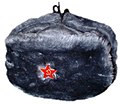
|
Ushanka | A Russian fur hat with fold-down ear-flaps. | |

|
Utility cover | An eight-pointed hat used by the US military branches within the United States Department of the Navy. | |

|
Vueltiao | A Colombian hat of woven and sewn black and khaki dried palm braids with indigenous figures. | |

|
Whoopee cap | A skullcap made from a man's felt fedora hat with the brim trimmed with a scalloped cut and turned up. | |

|
Wideawake | A broad brimmed felt "countryman's hat" with a low crown. | |

|
Widow's cap | A cap worn by women after the death of their husbands. | |

|
Wizard/witch hat | A conical hat with a wide brim and a crooked top, traditionally associated with fictional wizards or witches. | |

|
Zucchetto | Skullcap worn by clerics typically in Roman Catholicism. |
See also
References
- "The Akubra Story". Akubra Hats. Retrieved 2024-09-25.
- "The Ascot Cap: What is it and How to Wear One". Fashionable Hats. 2019-01-13. Retrieved 2024-09-25.
- "Ayam". This is not a Hat. Retrieved 2024-09-25.
- Jones, Jo; Fidler, Matt; Conlon, Scarlett (2018-03-08). "Balaclavas and hi-vis: we know what you'll be wearing next autumn/winter". The Guardian. ISSN 0261-3077. Retrieved 2024-09-25.
- "Balmoral". Hat Guide. 2011-03-13. Retrieved 2024-09-25.
- "The red catalan barretina of Tió de Nadal & Caganer Catalan". Tió de Nadal. 2022-07-24. Retrieved 2024-09-25.
- "The Brief History of the Beanie Hat | Zaini Beanie & Bobble Hats". Zaini Hats. Retrieved 2024-09-25.
- Wharton, James (2024-09-16). "The bearskin: Everything you need to know about the iconic ceremonial headwear". www.forcesnews.com. Retrieved 2024-09-25.
- "History of the Beret". PieceWork. Retrieved 2024-09-25.
- "The Bhadgaunle Topi: A National Identity". ECS NEPAL. Retrieved 2024-09-25.
- "Bicorne". Dictionary.com. Retrieved 2024-09-25.
- "Encyclo - Princeton University - WordNet - a lexical database for the English language". www.encyclo.co.uk. Retrieved 2024-09-25.
- Agung, Firdaus (2023-07-20). "Blangkon di Antara Asal-usul dan Simbol". tirto.id (in Indonesian). Retrieved 2024-09-25.
- "Boater Hats: A Guide to History, Trends, and How to Wear Them". Sandoval. 2023-04-18. Retrieved 2024-09-25.
- "The History Of Boonie Hats In The U.S. Military". USAMM. 2022-03-11. Retrieved 2024-09-25.
- "Stories Ottoman Objects Tell". mediakron.bc.edu. Retrieved 2024-09-25.
- "The Boss of the Plains Still Reigns: The History of the Cowboy Hat". Ranchlands. 2021-06-30. Retrieved 2024-09-25.
- "Boudoir cap | American". The Metropolitan Museum of Art. Retrieved 2024-09-25.
- "Bowler hat makes a comeback". The Telegraph. 2010-10-05. Retrieved 2024-09-25.
- "History of the Breton cap". Gr8 Hats. 2023-10-22. Retrieved 2024-09-25.
- "Budenovka". bridgetomoscow.com. Retrieved 2024-09-25.
- "Busby | headdress | Britannica". www.britannica.com. Retrieved 2024-09-25.
- Harris, Karen. "Late Medieval Bycockets". www.larsdatter.com. Retrieved 2024-09-25.
- "What is a Campaign Hat?". CavHooah.com. 2023-04-12. Retrieved 2024-09-25.
- Kinney, Alison (2016-01-08). "How the Klan Got Its Hood". The New Republic. Retrieved 2024-09-25.
- "Capotain – tall-crowned, narrow-brimmed, conical hat". Hat Guide. 2011-03-11. Retrieved 2024-09-25.
- "Ecclesiastical Vesture: The Cappello Romano or 'Saturno'". Retrieved 2024-09-25.
- "Cartwheel Hat". Vintage Fashion Guild. Retrieved 2024-09-25.
- Sidwells, Chris (2016-11-01). "How to wear a cycling cap". cyclingweekly.com. Retrieved 2024-09-25.
- "caubeen". Oxford University Press. Archived from the original on March 16, 2012.
- Cunnington, C. Willett; Cunnington, Phillis (1972). Handbook of English Costume in the Seventeenth Century (3rd ed.). London: Faber and Faber. pp. 24, 65–69.
- Klinkenborg, Verlyn (2009-02-03). "Season of the chullo". International Herald Tribune. Retrieved 2011-07-02.
- "Malema under fire over slur on Indians". News24. 2011-10-20. Retrieved 2013-06-16.
- Most current dictionaries do not record any offensive meaning ("an unskilled laborer or porter usually in or from India hired for low or subsistence wages" Merriam-Webster) or make a distinction between an offensive meaning in referring to "a person from the Indian subcontinent or of Indian descent" and an at least originally inoffensive, old-fashioned meaning, for example "dated an unskilled native labourer in India, China, and some other Asian countries" (Compact Oxford English Dictionary). However, some dictionaries indicate that the word may be considered offensive in all contexts today. For example, Longman Archived 2006-11-27 at the Wayback Machine's 1995 edition had "old-fashioned an unskilled worker who is paid very low wages, especially in parts of Asia", but the current version adds "taboo old-fashioned a very offensive word ... Do not use this word".
- Millinery Madness: Hat Makers With Attitude
- Vibbert, Marie, Headdresses of the 14th and 15th Centuries, No. 133, SCA monograph series (August 2006)
- Haug, Joanne. "Victorian Smoking Cap". Victoriana Magazine. Retrieved 9 June 2014.
- Snyder, Jeffrey B. (1997). Stetson Hats and the John B. Stetson Company 1865–1970. Atglen: Schiffer. p. 5. ISBN 0-7643-0211-6.
External links
 Media related to Hats by type at Wikimedia Commons
Media related to Hats by type at Wikimedia Commons